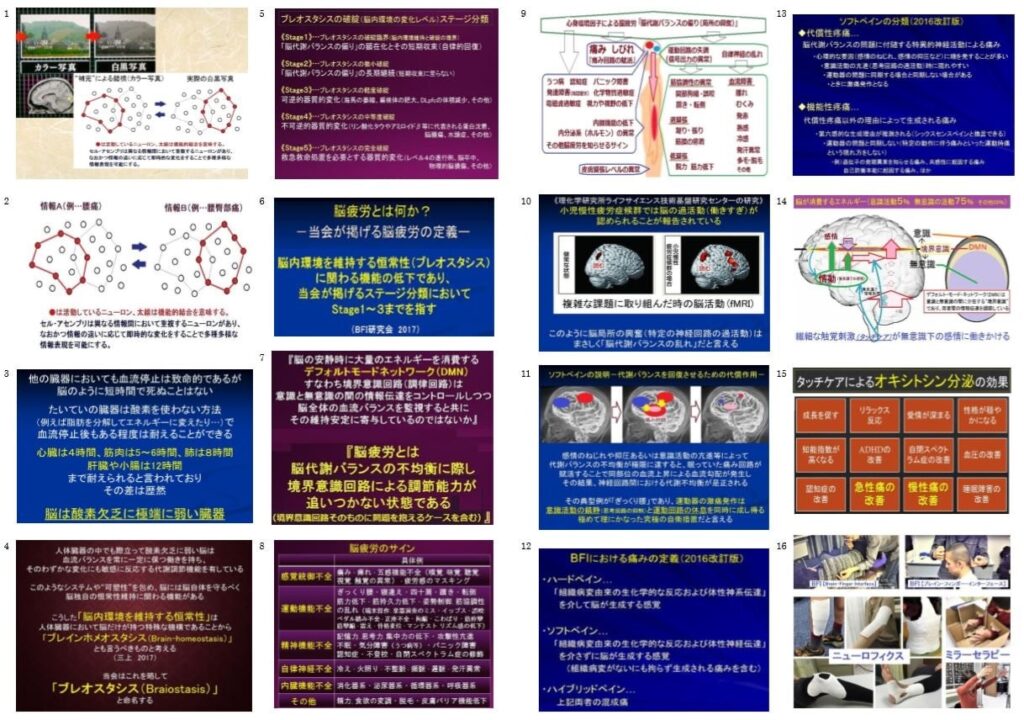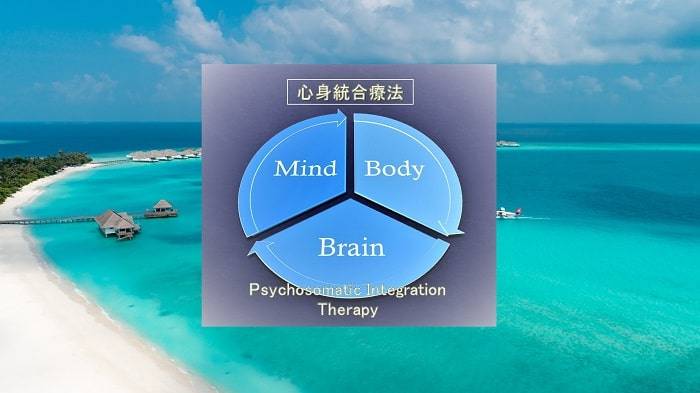
2018年(H30年)10月21日に催された一般講演会「痛みとは何か?-その深淵なる世界-」。おかげさまで前回、前々回に引き続き60名満員御礼となりました。
以下はマスコミ関係者の取材記事を一部リライトしたものです。
プロローグ
このたび「脳と痛みの関係」をテーマにした講演会に参加してまいりました。演題は「痛みとは何か?-その深淵なる世界-」。主催はBFI研究会。今回で4回目を迎える一般向けの講演会。
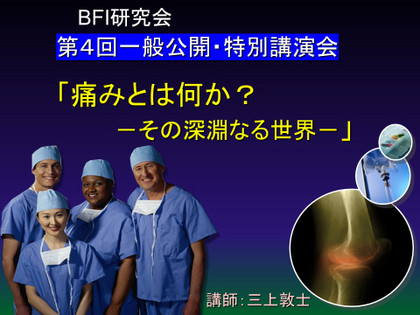
主催者によれば、これまで3回にわたる講演-「痛み記憶の再生理論」 「脳疲労とタッチケア」 「究極のタッチケア“BFI”とは何か」-において、理論的な説明は尽くされいるとの由で、今回は実際の症例をお伝えすることが主意とのこと。
最初に受付を済ませると、A3用紙一枚の資料が手渡されました。
渡された資料は過去の講演で上映されたスライドの一部だそうで、順に目を通していくと、脳と痛みの関係が脳疲労という概念の下に説明されていることが直感的に伝わってきました。おかげで初めて参加した小生でも、おおまかなイメージを持つことができました。
痛みの原因論
講義の時間は12:30~15:00で、休憩2度をはさむ3部構成となっており、第1部は手元資料の最初の部分(脳内で痛みという感覚情報を表現する神経回路の説明図)を体感する演出からのスタート。
特殊加工された風景画の一点を20秒ほど見つめたあと、同じ風景画がモノクロ画像に切り替わった瞬間、一瞬それが鮮やかなカラー画像に見えるという視覚の錯覚現象(色の残効)を体感!とてもリアルなカラー画像が確かに見えて、そのあと白黒に…。なんとも不思議な現象を体感しました。
。
講師によれば、こうした脳が創り出す錯覚は“補完”と呼ばれており、脳はこの他にも多種多様な錯覚現象を“創り出して”おり、痛みを表現する神経回路もこうした補完と同じ仕組みで“創られる”場合があって、しかもこうした痛みは従来の常識では考えられないほど「実際の臨床では多い」のだそうです。
こうした脳の情報表現に由来する痛みは、コンピュータに譬えると論理的障害すなわちソフト・アプリの問題を知らせるサインであることから「ソフトペイン」、ケガや炎症による痛みは物理的障害すなわちハードの問題(部品の故障)を知らせるサインであることから「ハードペイン」、両者の混成痛を「ハイブリッドペイン」と呼んで、新たな分類-痛み概念のパラダイムシフトーを提起しているそうです。
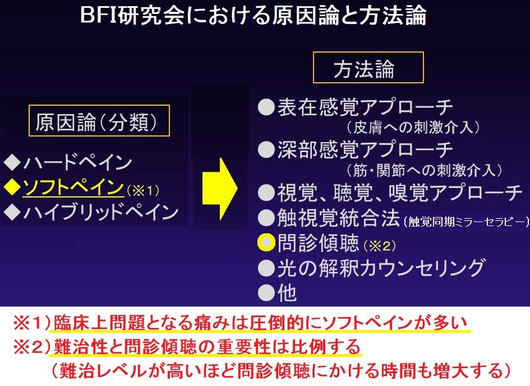
他方、医学の成書では①侵害受容性疼痛(ハードペイン)、②神経障害性疼痛(ハードペイン)、③心理社会的疼痛(ソフトペイン)という分類になっているそうで、しかし…。
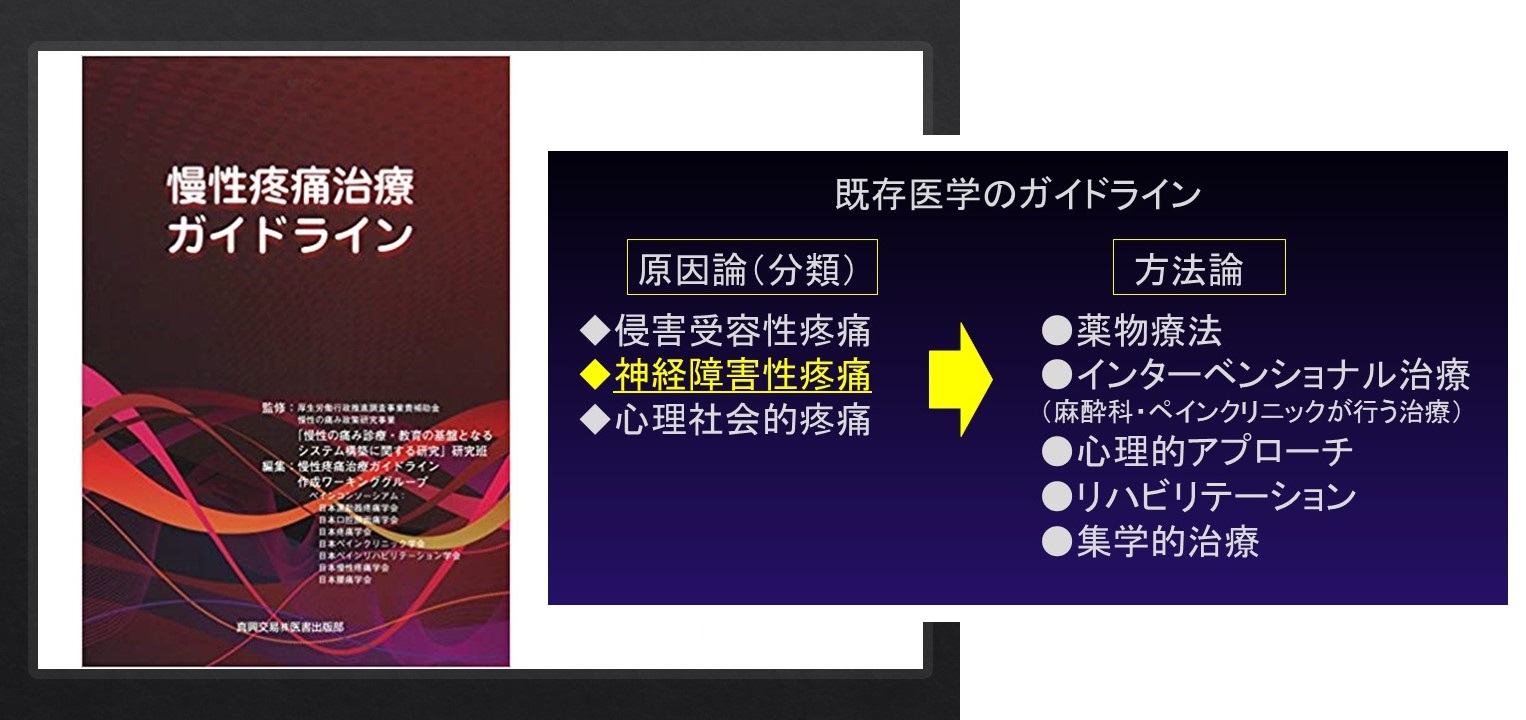
昨今②神経障害性疼痛という用語がテレビCMで頻繁に目にするようになった背景に…。
主に脳をターゲットにしている麻薬系の鎮痛剤や抗うつ剤が、近年の研究によって脊髄後角での下行性抑制系(※)に関与するというお墨付き(論文報告)を得たのを機に、
下行性抑制系に作用する薬を処方するためには
そのため診察現場において「あなたの痛みは神経痛です」と説明された上で、従来は癌性疼痛やうつ病に処方されていた薬が、今では慢性痛に投与されているとのこと。
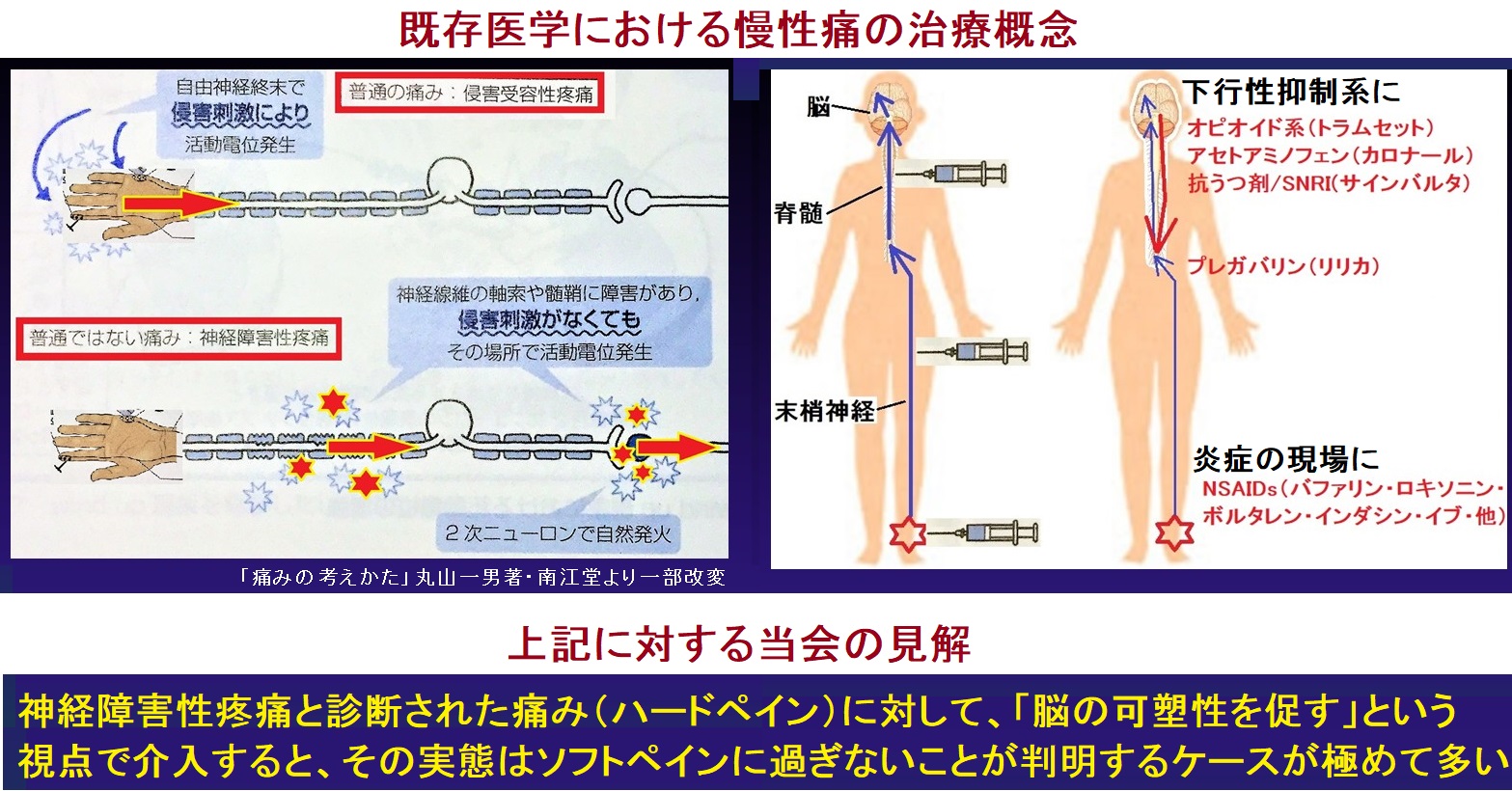
『

〈ミラーセラピーで改善する痛みの正体はハードペインではなくソフトペインと考えるのが自然です、と講師の弁〉
ミラーセラピーは脳の可塑性を促す手法ですので、これにより改善する痛みはソフトペインと見なすことができます。つまり四十肩の痛みは既存医学が説明するような“部品の損傷や炎症(ハードペイン)”ではないということです。
痛みのみならず、動き(可動域)も回復することから、腕が上がらない理由も脳の次元(運動回路の出力エラー)であることが分かっています。
さらに「動きが回復しても痛みだけ不変」という症例やその反対のケースもあることから、 脳内の「痛み回路の賦活」と「運動回路のエラー」が同期した場合に「腕が上がらなくて痛い」となり、同期しなければ、つまりどちらか一方であれば 「なんとか上がるけど、とにかく痛い…」 もしくは 「そんなに痛まないけど、とにかく上がらない…」 となる、そういう分析に帰結します。
四十肩に限らず、あらゆる運動器疾患や神経障害性疼痛と診断された痛みに対して、脳の可塑性を促すアプローチ(当会が研究開発を進めている“BFI”というタッチケアの一種)を行っていくと、ほとんどの痛みが実はソフトペインであることが分かってきました。
当会の臨床データにおいて、本物の神経障害性疼痛(ハードペイン)というものは極めて少ないことが判明しています。そもそもソフトペインだからこそ脳に作用する薬が効果を現すわけで…。
それなのに薬の保険適用といった次元によって痛みの実態がゆがめられて患者さんに伝わり、その結果“神経痛”という呪いをかけられてしまう…、本当は脳システム由来の痛み(ソフトペイン)に過ぎないものが、神経が傷んでいるから痛いんだ、神経が圧迫されているから痛いんだと思い込まされてしまう…、そんな由々しき事態に陥っているんです』 .
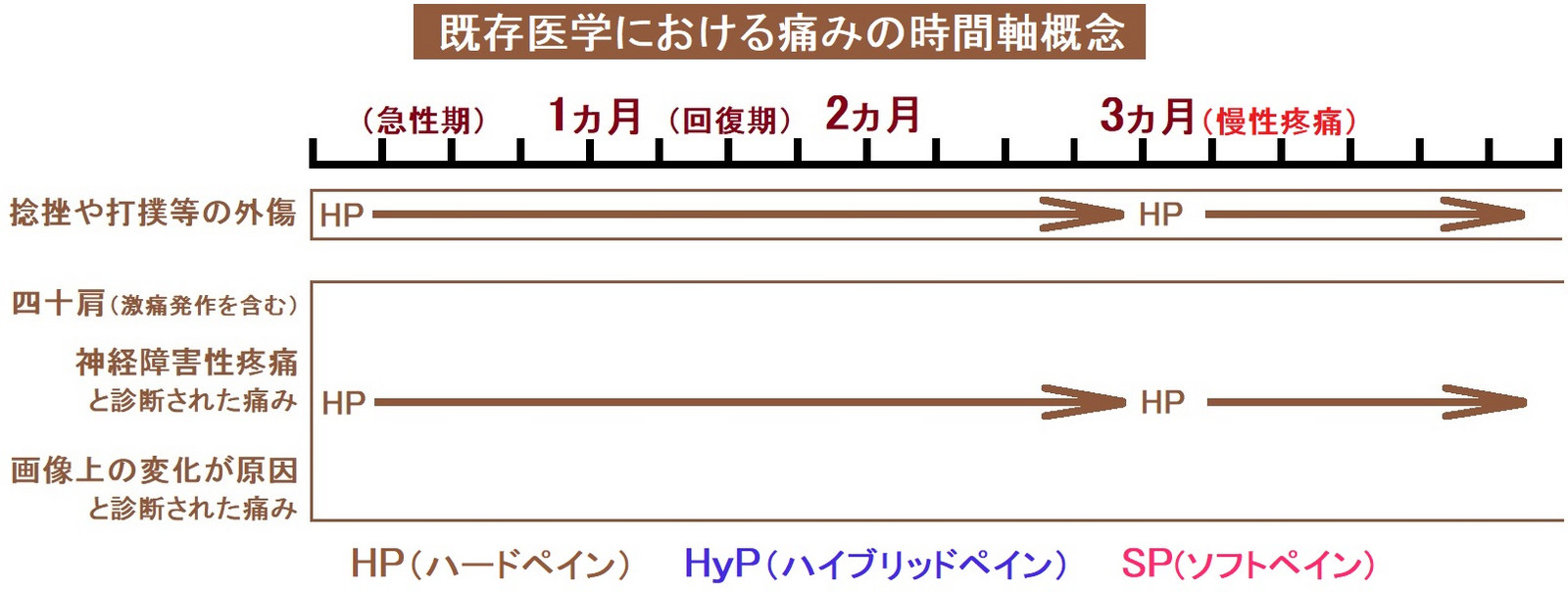
.
.
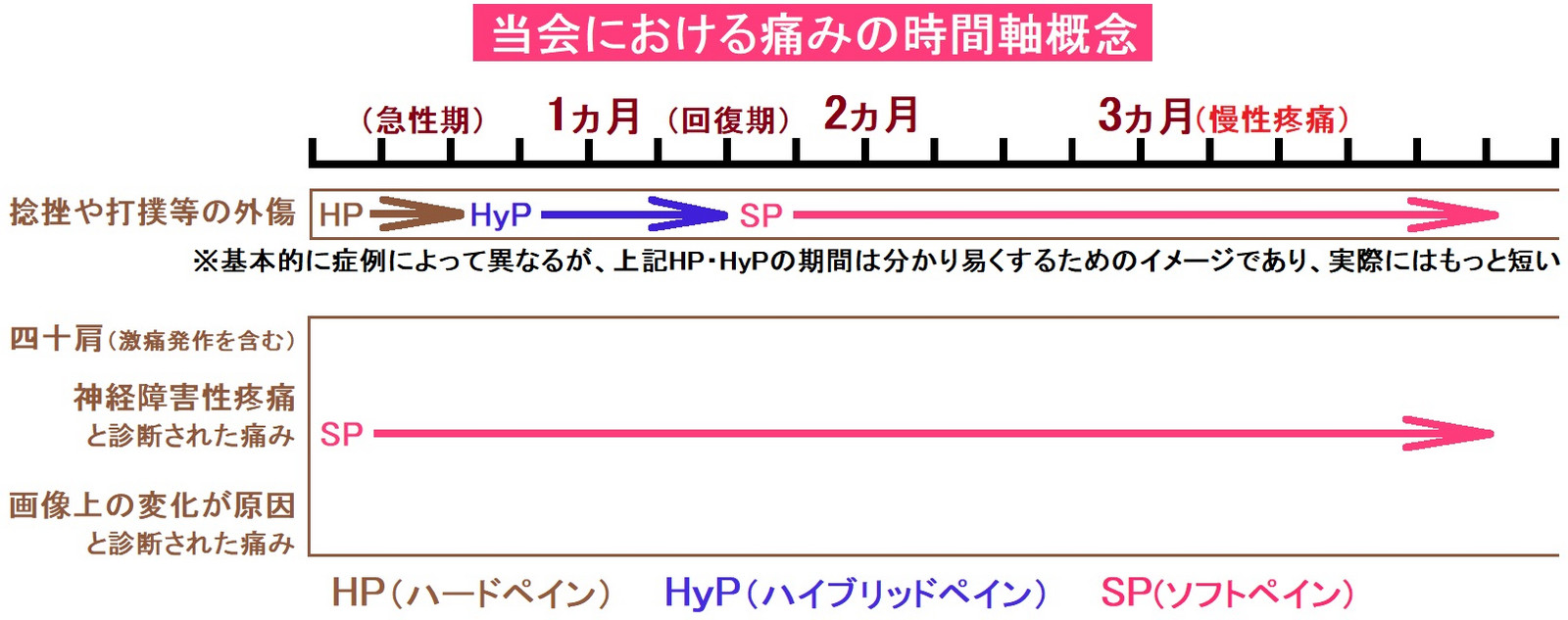
そう言われてみると、たしかに…、なんとか疼痛という言葉が妙に強調されていたテレビCMが思い出されました。名優による独特の語り口の裏にそんな事情が隠れていたとは…。
※参考記事→『乱用される国内販売トップの鎮痛薬「リリカ」…効能が実証されていない適応外処方が患者を苦しめ、医療費増加を招く』
講師によれば、既存医学における痛みの概念は混沌として定まっておらず、これに世界各国の民間療法における痛み概念が入り混じってくると、もう…、そこはカオス以外の何物でもないのだそう。
その淵源にあるものは…、多くの医療者が「痛みを出している肉体」と対峙しており、「痛みを出している個人」と向き合おうとする現場があまりに少ない…、その結果、脳の次元を視野に捉えられる医療者が未だ僅少であることが、痛み概念の世界的統一を妨げていると、氏は訴えます。
とは言え…、たとえ脳の次元に辿り着いたとしても、研究者のあいだで足並みが揃っているかと言えば…?そうした医療者のあいだでも、様々な脳原因論が語られているとのこと。
。
その背景には脳科学を享受する際の診断哲学に問題が潜んでおり、昨今の脳機能イメージングの発展によって脳局在論に陥ってしまっている研究者があまりに多いのだそうです。氏はこうした状況をたいへん憂慮していました。このままでは整形の画像診断と同じ轍を踏むことになる…、と。
。
『例えばfMRIなどに描出される脳機能画像は酸素消費や血流等の局在性を現していますが、赤いエリアと青いエリアにおけるエネルギー消費の差はせいぜい数パーセントに過ぎないんです。
。
脳は常に全体が統合的かつ協調的に活動しているのであって、どこか局所のみが働いているわけではありません。脳はまさしくブラックボックス、複雑系の極みであり、今後は神経細胞(ニューロン)だけでなく、これまで黒子扱いだったグリア細胞についても解明が進んでいくはず…。
。
アルツハイマーの画像変化があっても、その3分の1は実際に発症しません。脳は宇宙と同じくらい深淵な世界…、画像の変化と痛みを短絡的に結びつけてしまった整形の過ちを二度と繰り返してはいけないんです』
。
と、氏は熱く語ります。こうした脳局在論の研究者が主導したテレビ番組やマスコミ露出を経て出版されたソフト論系の書籍が数冊ほど紹介されました。
。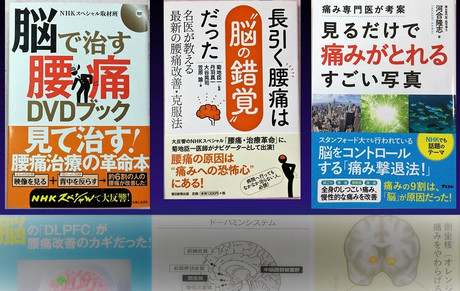
「側坐核やDLPFCの機能低下、扁桃体の過活動などが取り上げられていますが、これらと痛みの関係は相関関係であって、因果関係ではない(
譬えて言うと、オーケストラの演奏が良くなかったとき、バイオリンの誰それ、ビオラの誰それ、オーボエの誰それの演奏が拙劣だったと指摘しているのが局在論であり、一方で、指揮者のせいだと訴えているのが氏の視点。
人体臓器の中で際立って酸素欠乏に弱い脳、言い換えればエネルギー代謝における酸素依存度が非常に高い脳は、自身の血流バランスに敏感に反応する脳独自のホメオスタシス(これを氏はブレノスタシスと呼ぶ)を持っており、この機能の微小破綻が脳疲労。
プレノスタシスの微小破綻は冒頭で紹介した“補完”の仕組みを利用して痛み回路を賦活させる。これによる同回路の血流増加は結果的に代謝バランスの回復を促す。つまり痛みは脳恒常性機能不全(BD)を知らせるサインであると同時に、これを回復させる役割をも包含する。
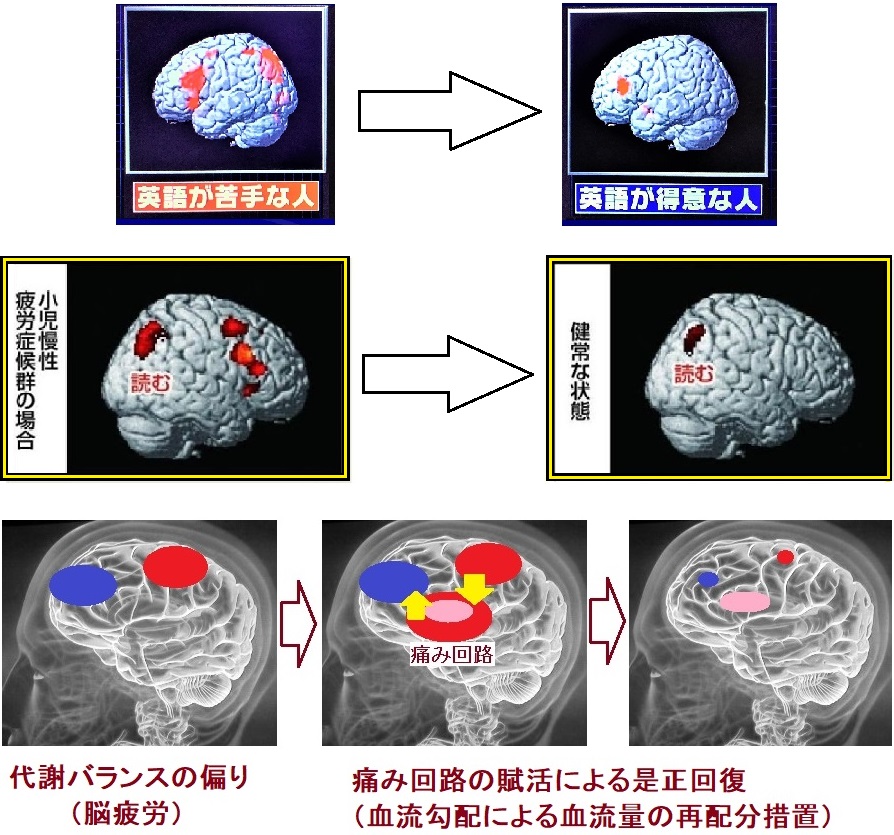
コンピュータにおけるソフトの問題(バグ)は“論理的障害”と表現されますが、ヒトの脳におけるソフトペインは“障害”という表現はそぐわないのだそう。先天性無痛症が暗示するとおり、生命を守る危機回避システムの一つとして捉えるべきとのこと。
既述のとおり「複雑系の極みである脳」にあっては、現人類の科学レベルではその全容解明まで相当に長い道のりが想定され、なかでも痛みのメカニズムは「意識のハードプロブレム-ヒトの意識はいかにして生み出されるか-」の解決なしには語れないのだそう。
そういった意味において最終的に量子力学の研究成果が突破口になるのでないかというのが、氏の予想です。
脳恒常性機能不全(BD)を引き起こす要因は外的因子と内的因子に分かれます。
前者は気象病に象徴される気候変化を含めた環境因子。
後者は脳腸相関すなわち腸内環境の乱れやメンタルバランスの乱れなどがあり、痛みの慢性長期化や激痛発作においては圧倒的にメンタル由来が多いと言えます。
昨今マスコミを賑わせている脳局在論は痛みの原因論としては甚だ不完全であり、かと言って、自説(脳代謝バランスの失調/脳疲労説)が最終回答かと言えば、それもおそらく今後の脳研究によって別の視点が浮上してくる可能性があります。
。
しかし、現存する原因論の中では最も合理性の高い解釈であろう…、と私は考えています。
。
脳機能イメージングの発展によって、それまで見えなかったものが見えるようになると、「すごい発見だ!」と歓喜してしまうのは心情として理解できますが、相関関係と因果関係の違いを見極める冷徹な視点が研究者には求められます。
。
痛みの構造破綻説を人類の脳にすり込ませてきたミスリードを二度と繰り返してはいけないんです
こうして痛みの原因論における俯瞰の視点が紹介されると、次に「心療内科と精神科の違い」について解説がありました。
ソフトペインとハードペイン
心療内科は主に心身症(こころの問題→身体の障害)を扱う科であり、精神科はうつ病に代表されるこころの病(こころの問題→こころの障害)を扱う科であることが紹介されました。
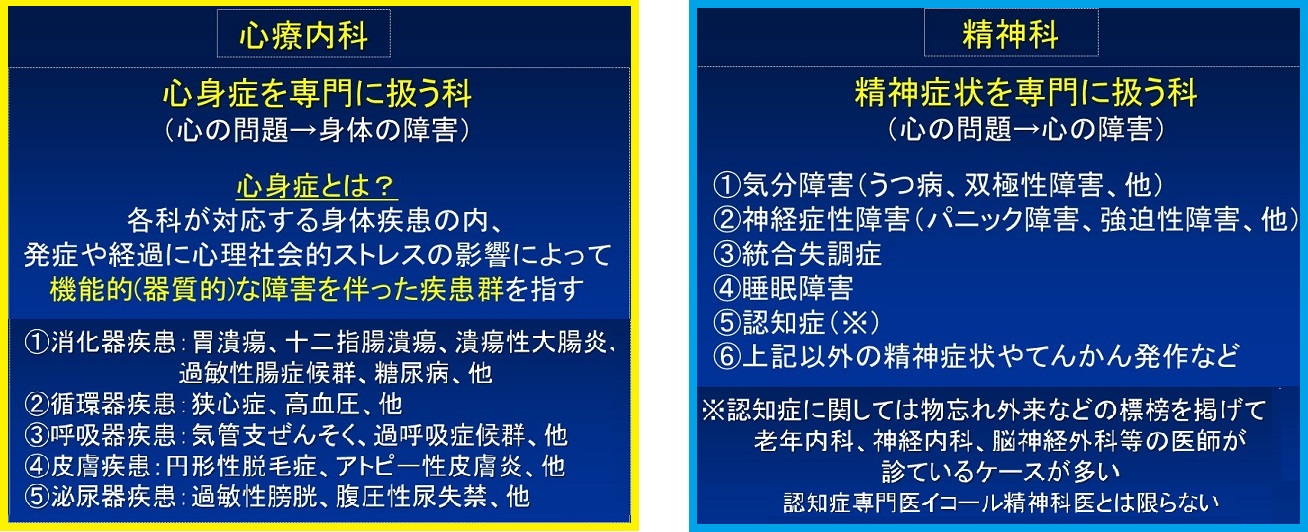
この両者について、小生は「どちらも似たようなところ」だと思っていましたので、「そういう違いがあったのか!」と驚きを隠せませんでした。
また羽田沖の日航機墜落事故(機長止めてください!の逆噴射事件)の際に、心身症という言葉が使用されたため、いまだに多くの人々が誤ったイメージを持ってしまっているそうで、これに対しても認識を新たにすることができました。
それにしても、日常にありふれた疾患の多くが心身症として治療されているとは…、まだ知らないことがたくさんあるのだなと痛感した矢先、そんな小生に追い打ちをかけるかのように夏樹静子氏の書籍が紹介され、続いて心療内科で恢復した実例の数々について説明がなされました。
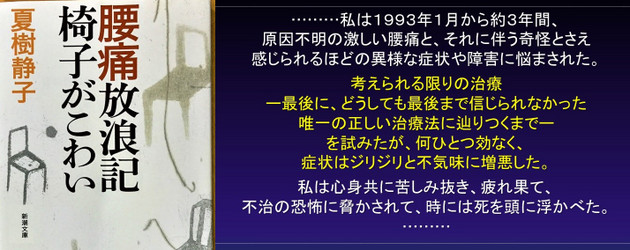
売れっ子作家が抱える無意識の苦悩が生み出す強烈ソフトペインの前に、痛み専門の名医、あらゆる鎮痛剤、名人達人の整体師、占い師らが首を垂れて惨敗し続ける中、本人が最後の最後まで「こんなにもリアルで激しい痛みが心因性であるはずがない」と頑なに反発し続けていた相手(心療内科の医師)を頼ることで、ようやく奇跡の生還を果たすことができた実話。
自死を考えるほどの凄絶なる激痛の正体が、実はソフトペインだったという衝撃的な結末を受けて、夏樹静子氏が心療内科を訪問してまわり、“同胞”たちにインタビューしたノンフィクションが紹介され、腰痛はもとより潰瘍性大腸炎のような難病までもが恢復した実例が語られました。

講師によれば、夏樹静子氏のように“人生が破壊されるほどの激痛”が長く続くケースは、その多くがソフトペインだそうで、さらにソフトペインは“あり得ない”ほどの皮膚変化を伴うことがあり、氏による実際の臨床例が紹介されました(下の写真)。

上の写真の内、左端が肋骨骨折で、それ以外は全て心因性に現れたものだそうです。これほどの皮膚変化がこころの問題から引き起こされるなんて、とうてい信じられませんが…。中でも、右端の足の写真は「血汗症」と呼ばれるもので、世界中でも数十例しか報告されていない稀少な疾患だそうです。
汗に血が混じる大変珍しい現象ですが、古くは聖書にも記載があって、キリストが十字架にかけられる前夜、血の汗を流したと記されているとのこと。この現象もまた強い心理的ストレスによって現れることが氏の臨床で確認されています。
中央の手の写真(腫脹発赤→浮腫光沢化)は、氏の母親に発症した複合性局所疼痛症候群/CRPS(RSD)。
様々なタイプがあるCRPS(RSD)の中でも、氏の母親は自然発症(就寝中に突然、右手の激痛発作が起きて、数日後には写真の状態に…)でしたが、この疾患群は骨折などの外傷後に現れることが多いため、既存医学の現場はハードペインバイアスー損傷部位から生じる痛みという先入観-に支配されているそうです。
しかし、氏によれば、そのほとんどは夏樹静子氏と同じ性質の痛み(ソフトペイン)であり、そこに交感神経の問題-腫脹、浮腫、皮膚変化、組織の萎縮-が同期するかしないかの次元に過ぎないと断言しておられました。

さらに昼夜を問わず母親の激痛と対峙し続けた臨床は、「ソフトペインには寝たきりになるような大うつ病や認知症を回避させる役割がある」ことに気づかされるきっかけとなった、たいへん貴重かつ稀有な体験だったそうです。
ちなみに氏の母親にCRPS(RSD)を発症させた真の原因-真犯人-は何を隠そう息子、つまり“講師本人”だったそうで。
ずっと長い間、夫と二人暮らしだった母親。その生活がある日を境に一変。息子(氏)夫婦の側の事情により急遽、同居せざるを得なくなり…(母親の本心は嫁に気を遣うのが嫌で同居したくなかった)。
ところが同居生活が始まって半年後、夫と息子(氏)の緊張関係が勃発。その板挟みに遭って精神をすり減らしていくなかでの発症でした。
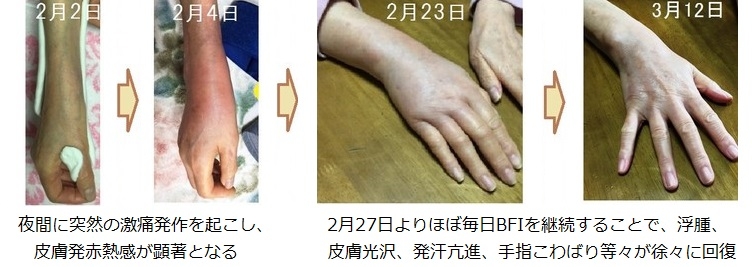
実は数ヶ月前から抑うつ状態だったそうで、母親の脳は自ら激烈なるソフトペインを出すことで“大うつ病を回避した(うつ病の重症化を未然に防いだ)”というのが氏の解釈(同時に認知症を回避したとも言える)
それにしても、これほどの変化がこころの問題から生じるとは本当に驚きですが、ある意味人間という生き物を象徴する現象なのかもしれません…。
これまで医学界は 「痛み=ハードペイン」 と頑なに信じてきました。
確かにくも膜下出血や大動脈解離などの激痛に象徴されるように、生命の危険を知らせるハードペインは強烈なインパクトをもって医療者の記憶、知識にすり込まれています。しかし救急医療体制の整った先進諸国では原疾患に対する対応が痛みの消失につながる場合がほとんどです。
そうしたハードペイン自体が“治療対象になる”ことはまずありません。痛みのコントロールという次元において問題となってくるケースすなわち人々を悩ませ、苦しませる“慢性痛”のほとんどは生命の危険を知らせるサインではなく、ソフトペインだというのが氏の主張です。
腰痛や肩こりといった慢性痛の患者さんにガンが見つかると、「長いあいだ私が感じていた、あの腰痛はガンのせいだったんだ」と考えてしまいがちですが、氏によれば「慢性痛とガンの関係を証明する科学的根拠は一切なく、ソフトペインを出している生体にガンが見つかった、すなわち次元の異なる2つの現象が一生体内で同期したに過ぎないと考えるほうが論理的整合性に優る」とのこと。
そもそも癌性疼痛(ガンによる痛み)と考えられているものの中には、実は相当数のソフトペインが含まれているというのが氏の見解であり、そう考える根拠については本講演の最後に語られます。
『認知神経科学の発展、心理社会的アプローチ、脳の可塑性に関わる臨床研究(その中の一つがBFI研究会)によって、ソフトペインは重箱の隅をつつくような僅少の出現頻度ではなく、実はハードペインよりも圧倒的に多いことが判明しており、こうした痛みのパラダイムシフトを一刻も早く教科書の記述に反映させる必要がある』と、氏は強い口調で訴えていました。
典型的なハードペインのひとつ、ケガの痛み(外傷性の痛み)…。これすら、それを感じる時間というものは「実は想像以上に短い」ということを氏は自らに課した人体実験によって確認しています。

自分の足にガラス板を落として骨折させるという、なんとも常軌を逸した、俄かには信じ難い実験ですが…。これを行った結果、急性外傷による純粋なハードペインは数十秒間も続かないそうで、ただちにハイブリットペインに移行し、48時間後に感じる痛みは間違いなくソフトペインだったというのが、氏の分析です。
さらに受傷2日後の皮膚所見の違い(上記右端の写真)を受けて、氏は以下のように論じています。
あくまでも私個人の見解ですが、信号入力の選択(ゲートの開閉)は最終的に脊髄より上位すなわち脳において、デフォルト・モード・ネットワーク(※)をはじめとする同期性広域神経回路がその任に当たっており、これらは意識と無意識の境界を成していると推論されることから、私はこれを境界意識回路と呼んでいます
※…
なんだか、もう、ここまで来ると…、小生のような素人にはとうてい理解の及ばない世界ですが、数百年後の人類社会では「痛みのソフトペイン学説」が常識になっているというのが、氏の未来予想図です。
さて、ここまで前振り(前説)が長くなりましたが、ここからがいよいよ本講演のメイン-ソフトペインを出す人々にはどんな人生ドラマがあって、どんな救いがもたらされたのか?-を紹介させていただきます。
氏が唱える「痛みのパラダイムシフト」…、その源流をたどる旅とでも言いましょうか、その原動力-診察現場の空気-が肌で感じられるような生々しいやり取りが、まるで再現VTRを見せられているかのように、氏による臨場感に溢れた独演会がはじまりました。
本講演で紹介された症例の個人情報は当然ながら全て伏せてあり、名前、年齢、職業、家族構成、地域名等々のあらゆる固有名詞はすべてフィクションに置き換えて、物語の文脈のみが忠実に再現されているとのこと。
症例1

症例1)は発達個性(※)境界例-確定診断に至らないまでもその傾向を有している例-の小学生に発症した反応性障害。その本態は脳疲労であるというのが氏の視点。
(※)…BFI研究会では発達障害という用語に代えて、“発達個性”という呼称を推奨している。
腹痛、下痢、倦怠感、激しい腰痛といった一連の症状に対して、内科、小児内科、整形のいずれにおいても本人の核心部分を素通りする中、氏の診察においてBFIの施術はもとより発達個性に関わる説明、食生活の指導、母親のメンタル面へのフォロー、そして心理的介入を断固として受け付けない本人の頑なな心性を見抜いた上で行われたカウンセリングの妙が再演されました。
氏による至適な距離感を保つ介入が功を奏した事例であり、患者さんとの信頼関係がいかに繊細かつ慎重なプロセスを経て構築されていくのかが“見える”好例でした。
下図は発達個性の分類概念(DSM-5参照)。
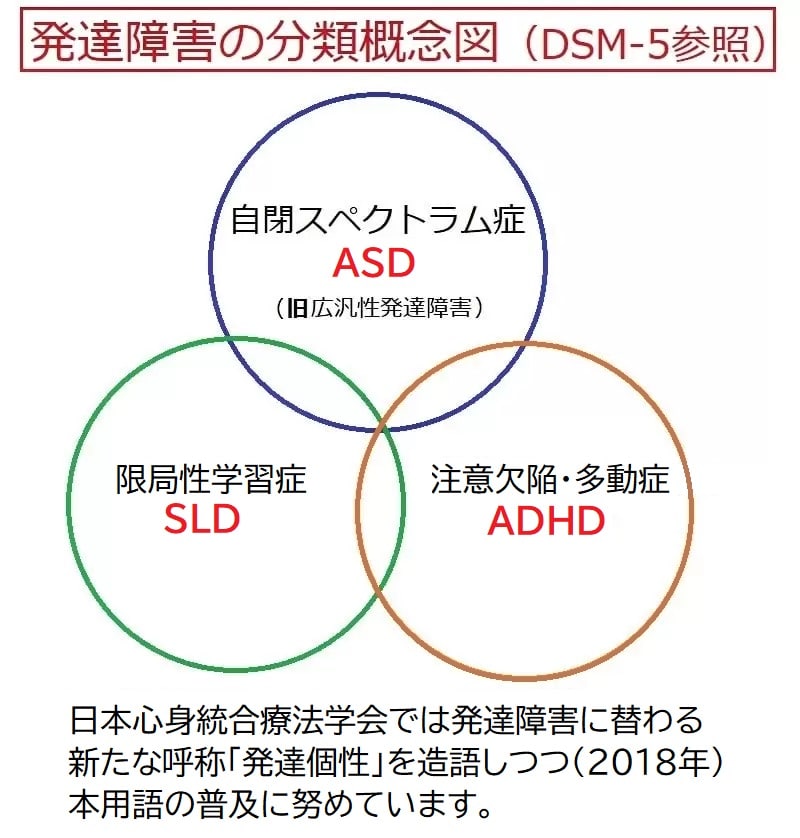
講師によれば、今、発達個性が爆発的に増えているそうで…、その理由についてはガイア理論の視点で説明できるというのが氏の見解です。これについては「機会を改めて講演したい」とのこと。
「実は私自身も発達個性です。こんな風に早口になっちゃうのも、そのせいかと…、ホントすみません(苦笑)」。
発達個性と痛みの関係についてはこちらのページで解説しています。
症例2
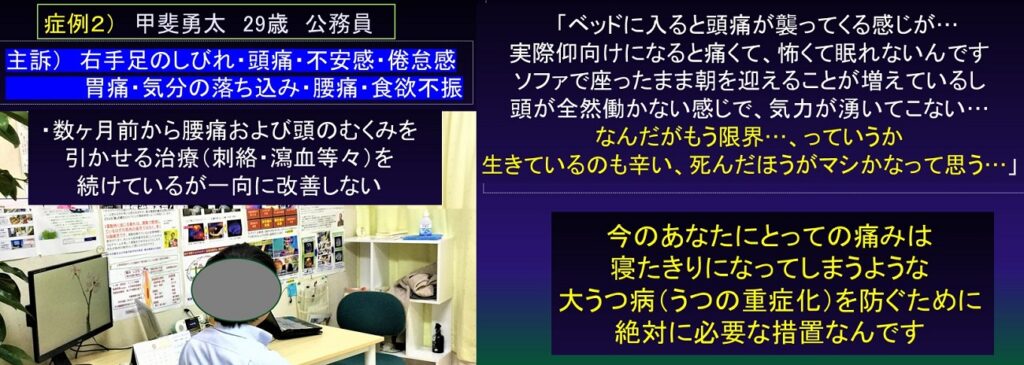
症例2)は抗うつ剤の副作用に苦しんだ経験を持つ男性が、薬に頼らない方法でなんとか脱出を試みるべく“格闘”のごとき事例。
希死念慮を伴う危険な状態に対して、氏が連日にわたる施術、問診傾聴、光の解釈カウンセリングを続けることで生還を果たした決死の脱出劇。この症例について語る氏の迫真の口演はこちらのページ(YouTube)で視聴できます。
症例3

症例3)は軽度認知障害(MCI)と言われた女性の症例。氏はすでに認知症を発症していると判断し、発症に至る経緯を詳しく知る必要がある旨、付き添いの娘さん(長女)に告げて協力を仰ぐも、なぜか非協力的な姿勢…。
氏によれば、認知症のリスクとして、脳恒常性機能不全(BD)のマスキングや何らかの心理的抑圧が挙げられるそうで、その核心が分かれば、真の予防策、真の対策が見えてくるのだそう。
家庭内の様子がほとんどうかがい知ることができない中、BFIの施術による認知機能の改善だけが現れ…。患者さんの実情が分からないまま症状のみ改善するという流れは氏にとって本意ではなく釈然としない様子…、しかし無情にも長女の判断で通院が中止されてしまい…。
ところがその数か月後、同居する次女の来院によって一気に謎が解けていき、そして…。
.
症例4

次女の証言を受けて、母親の過去がようやく判明。認知症の裏に夫の問題-家庭内パワハラ、隣人トラブル、アルコール依存等々-があることが分かり、その一つ一つに丁寧な助言、光の解釈カウンセリングを2年以上にわたり粘り強く続けていくことで、同居する次女を介して間接的に母親の認知症を改善させつつ…。
当の次女本人にも母親以上に壮絶な過去があり、うつ病発症の背景が詳らかになっていき…。
そして本人の人格形成に大きな影響を与えたであろう父親との関係性に迫るなかで、光の解釈カウンセリングの実効性-真の威力-が開示されました。無意識に封印していた記憶の扉が開かれることで、父からの不器用ながらも無償の愛に気づいた本人が号泣する場面では、会場のあちらこちらですすり泣く声が…。
そして親子が互いの運命を乗り越えて救われた感動の結末を迎えると、どこからともなく自然と拍手が沸き起こっていたのでした。
症例5
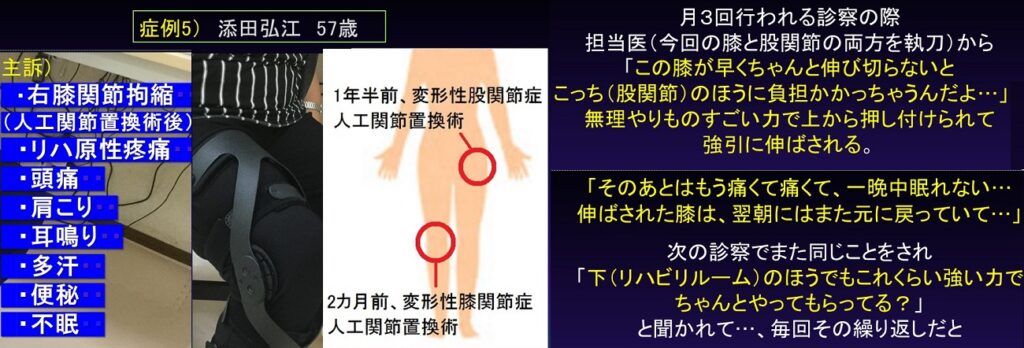
症例5)は変形性関節症の診断の下、股関節と膝関節の人工関節術を受けた女性に待ち受けていた医原性疼痛の事例。痛みに対してあまりに無知な執刀医が行う暴力的な矯正行為。その執刀医からのプレッシャーを受けて、結果を出さねばと焦る若きPT(理学療法士)。脳と痛みの関係を知らない現場に潜む危うさ…。
ネットでリハビリと痛みの関係を調べた際に、BFI研究会のサイトに辿り着いたという女性はBFIの施術(
しかし、この方もまた家族問題の渦中にあることが氏の問診傾聴によって…。独り暮らしの高齢の母親がうつ病を発症している中、自身もまた独り身であるにも拘らず同居に踏み切れないでいる-同居したほうがいいのは分かっているけれど、同居したくない-、そんな内心の葛藤が浮き彫りになると、ここでもまた氏による巧みな問診傾聴が救いの扉を開くのでした。
本人のこころの氷を解かす一条の光が差し込み…。そしてこれ以上ないハッピーエンドに。その内容はこちらのページ(YouTube)で視聴できます。
「整形やリハビリの現場で複雑かつ不安定な経過をたどった挙句、医療不信を募らせてドクターショッピングに移行していく例が後を絶たない…」という氏の語り口は、ここでよりいっそう熱を帯び…。
「…だからこそ、教科書を書き換える必要があるんです。国家試験を突破することに汲々として知識を詰め込み、成書を鵜呑みにして現場に出てくる若い医療者たち…。彼や彼女たちがやがて何かしらのグループや学会に所属して色に染まる前に、ソフトペインの現実についてきちんと教わる必要があるんです」
症例6
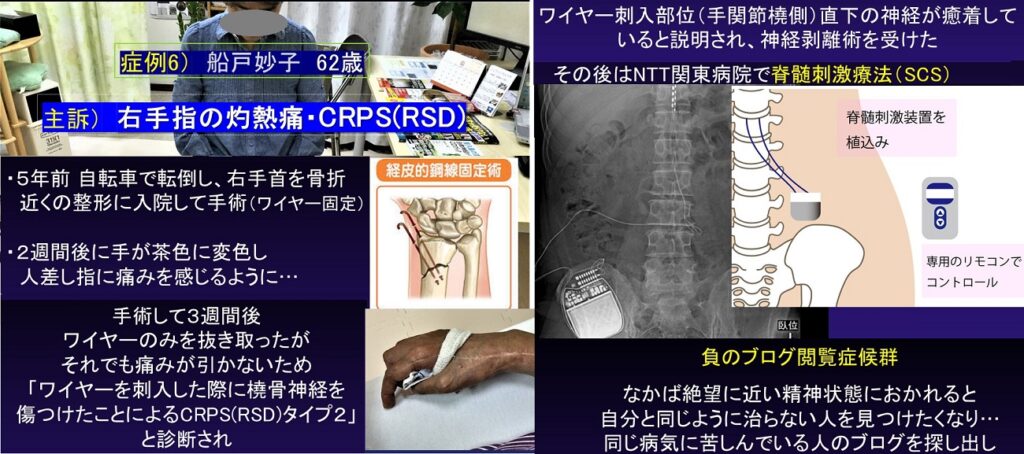
症例6)は患部を見て人を見ない-木を見て森を見ず-が招く悲劇の典型例。CRPS(RSD)に対するハードペインという思い込みがいかに患者さんの人生を狂わせるかを如実に物語る事例。
本人のメンタルに極めて深刻なダメージをもたらす大事件-愛する独り娘から“いわれなき絶縁状”が突然送られてくるという衝撃的な出来事-の発生と、手術のタイミングがたまたま重なったために、自律神経の乱れが氏の母親同様の皮膚変化をもたらし…。
これを神経癒着による症状と早計した執刀医による神経剥離術が、あろうことか三度も繰り返された結果、異常なほどの灼熱痛に襲われる地獄の日々が。
そしてSCS(脊髄刺激療法)に救いを求め、電池内臓の装置を体内に埋め込むことに…。ところがトライアルのときは効果があったものの、いざ実際に体内に埋め込んでみると、その後は効果が現れず、「今では通電スイッチを入れることはほとんどないんです…」と。
本症例は失感情症と失体感症を合併する発達個性であることが、氏の問診傾聴によって判明します。
氏がそうした本人の謎を解いていく過程は数年に及ぶ通院の中で、何度も地雷を踏みつつ、患者さんとの信頼関係の維持と決裂のあいだを行き来する消耗戦であったことが語られました。
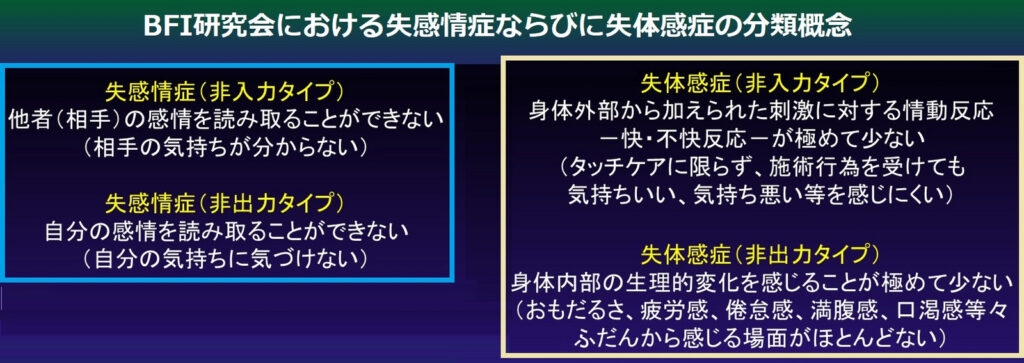
ちなみにこの症例は失感情、失体感ともに非出力タイプ。「これまで生きてきて、疲労というものを一度たりとも感じたことがない。口渇も感じないので、ふだん水を飲まない」と。典型的な脳疲労マスキングのタイプ〉
癌性疼痛とソフトペイン
こうして6症例、すべての紹介を終えたところでタイムアップと相成りましたが、癌性疼痛に対する考察が時間内に収まらなかったということで、講演終了後の質疑応答の時間を割いて行われました。
先述したように、氏によれば癌性疼痛の中には相当数、相当レベルのソフトペインが含まれているとのこと。
下図は「本物の鎮痛剤を服用した群」と「プラセボ(薬効のない偽薬)を服用した群」に分けて、それぞれの痛み改善率を比べた実験。
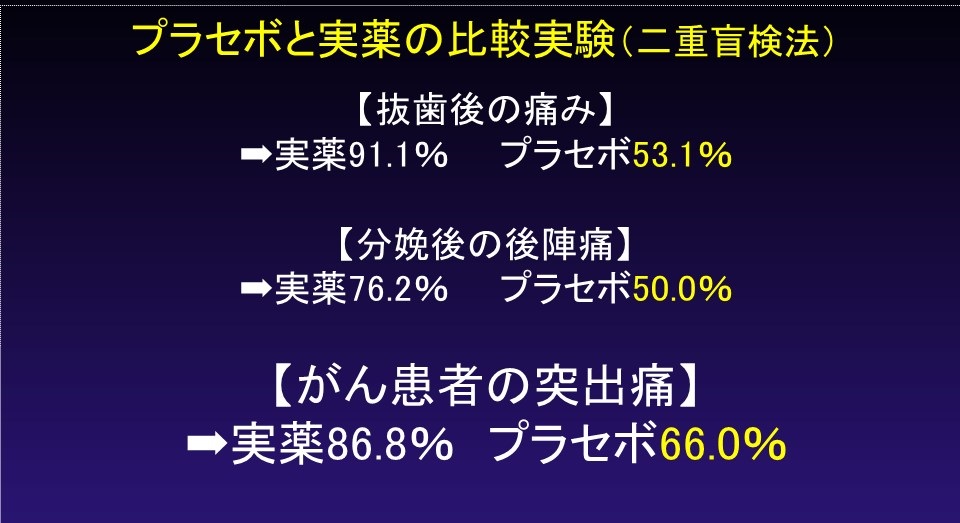
プラセボで改善する痛みとは何か?それこそがソフトペインだというのが氏の主張であり、これが事実なら驚愕としか言いようのない数字です…。
そして最後にガンとソフトペインの関係性に目が向くきっかけとなった、氏にとって忘れることのできない体験(ある症例)が紹介されました。
重度の変形性膝関節症(X線上の所見ならびに見た目のO脚変形も重度)の70代の女性。氏のところを含め4軒以上の病院で保存療法を受けていましたが痛みのコントロールができず、ついには本人が膝の手術を決断した時期、なんと偶然にも胃ガンが見つかりました
結果、胃の手術は成功し、事なきを得た女性は退院直後にふたたび氏のところを訪れました。その受診理由は膝ではなく、入院中に現れた腰痛だったそうで、あれほど女性を苦しめていた、変形が原因とされていた膝の痛みは、何と!完全に消えていたそうです(…にも拘らずX線所見やO脚変形は以前のまま)。
本講演の中で再三にわたって氏が主張してきたとおり、この女性の膝痛もまたソフトペインに過ぎなかったわけです。
胃ガンが判明したその瞬間から、女性の頭の中はそのことだけで目いっぱいとなり、膝のことはすっかり忘れていたとのこと。もし彼女の痛みが膝ではなく、背中だったとしたら、どうでしょう?きっと「背中の痛みは胃ガンのせいだった」と振り返ることになっていたはずです。痛みの場所がたまたま胃から離れていた部位(膝)だったが故に、胃ガンとの関連性に考えが及ばなかっただけで…。
先に紹介した「……、ソフトペインを出している生体にガンが見つかった、すなわち次元の異なる2つの現象が一生体内で同期したに過ぎないと考えるほうが論理的整合性に優る」という氏の考えは、こうした臨床の積み重ねに拠るとのこと。
『このように現実の臨床こそがガンとソフトペインの関係性を如実に物語っています!いつの日か、癌性疼痛に占めるソフトペインの割合-がん全体に占める出現率あるいは一個体内でのハイブリッドペインの内訳の比率の高いことが専門学会の場で証明されたなら、ガン治療の現場に新たな光を灯すことができる…』
そうした観点からもソフトペインという概念を喚起していきたい旨が語られ、大団円を迎えたのでした。
まとめ
最後に小生の感想を一言。
私が知る限り、氏のような早口で3時間近くしゃべり続ける講師は見たことがなく、早送りの動画再生をずっと見せられていたような疲労感を覚えましたが、同時に知らない世界の連続に圧倒され、自分の中の常識を疑うことも時に必要なのかなと思い直す好機になりました。
そして何より、最も印象的だったのは氏による問診傾聴の中身。生活環境に関わるありとあらゆる要素をくまなく聴取する姿勢。一歩間違えば、刑事の事情聴取かと見紛うほどに、何か執念のようなものすら感じる徹底した情報収集。そして何と言っても、氏の“聴く力”の凄さ。これには本当に驚かされました。
そうした情熱はいったいどこから来るのか?講演終了後に本人に尋ねたところ、とても分かりやすい答えが返ってきました。
一日100本の論文に目を通そうとも、月に何十冊もの本を読破しようとも、患者さんが体現する時間系列に符合する因果関係を理解する力がなければ何の意味もない…、優れた研究論文を生かすも殺すも臨床家次第…、理論と現実の径庭に対していかにバランスのとれた思考ができるか…、それこそが医療者にとって最も重要な資質なんです。
もちろん執拗な問診を不快に感じる患者さんもいらっしゃるわけで…、ですから相手の気持ちを十分に推し量り、尊重した上で距離感を少しずつ少しずつ丁寧に縮めていく配慮、本当にデリケートかつ地道な作業の繰り返しが、今の私の仕事なんです
なるほど…。ところで今後の動向について聴いてみたところ、将来的に日本認知科学統合療法学会なるものを構想しているそうで、そうした取り組みの行方も気になるところです。
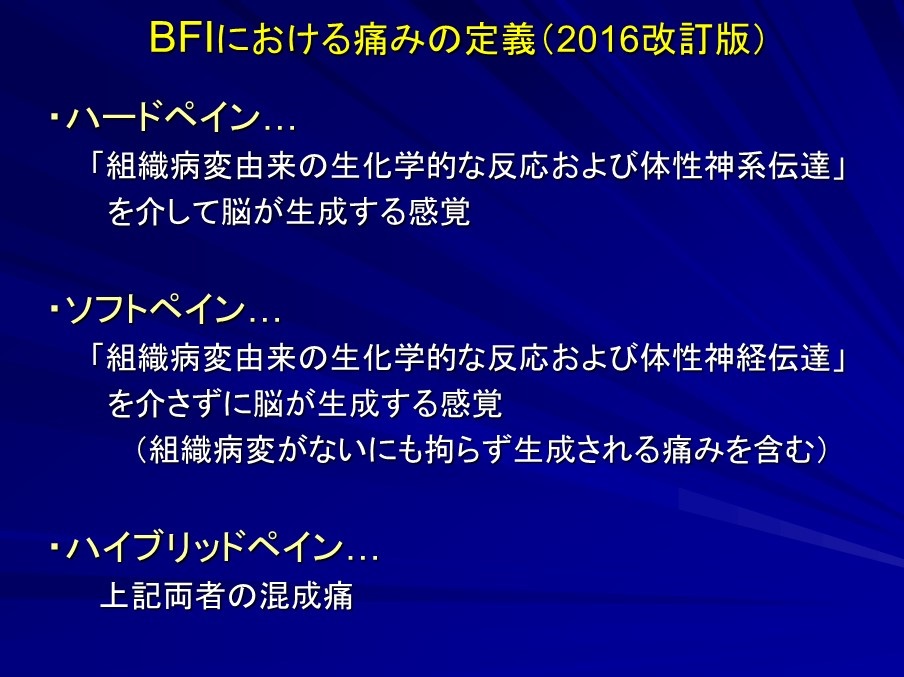
さて、「痛みとは何か?」という今回の壮大なテーマに対する講師の回答は
「境界意識のゲートが開くことによって生じる言語化され得ない情動出力反応」
だそうです。
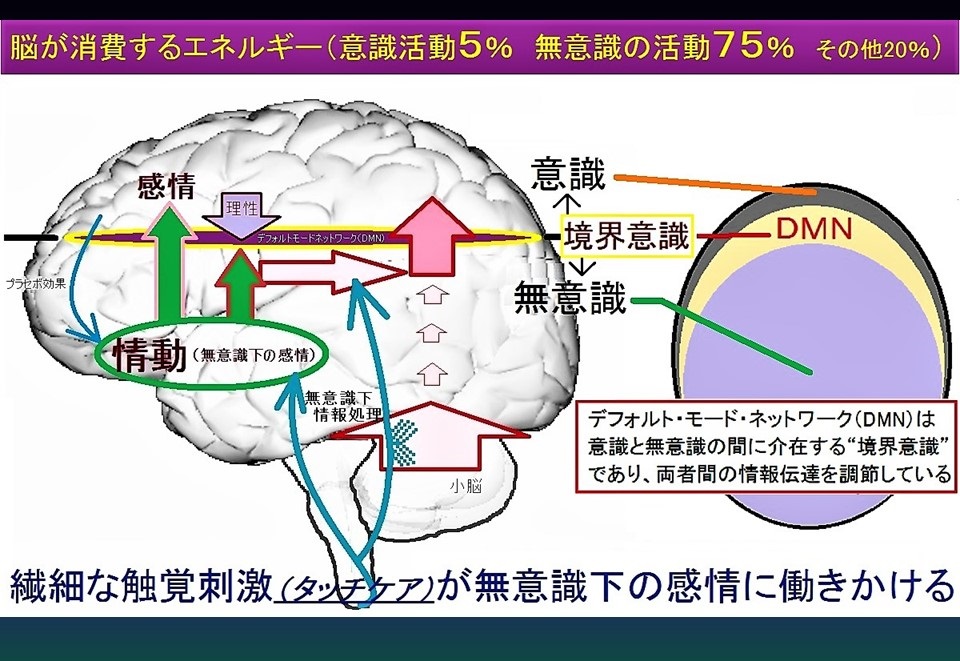
以上、一般講演会「痛みとは何か?-その深淵なる世界-」の概要報告でした。
参加者のアンケートより
以下に参加者アンケートの一部を掲載します。紙面の都合上、すべてを紹介することはできませんが皆様から頂いた貴重なご意見を胸にとどめ、次回の講演に活かしてまいります。ご出席いただいた皆様に心より御礼申し上げます。
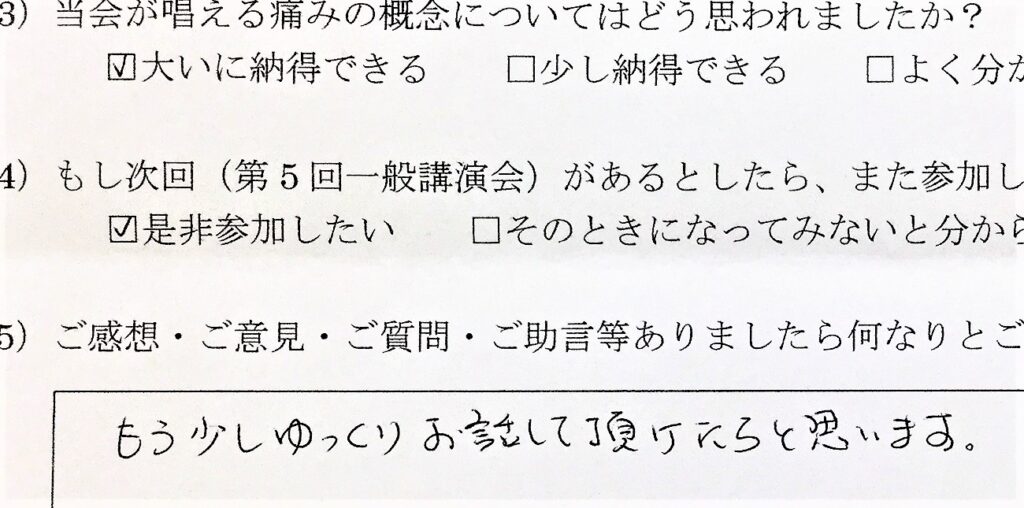
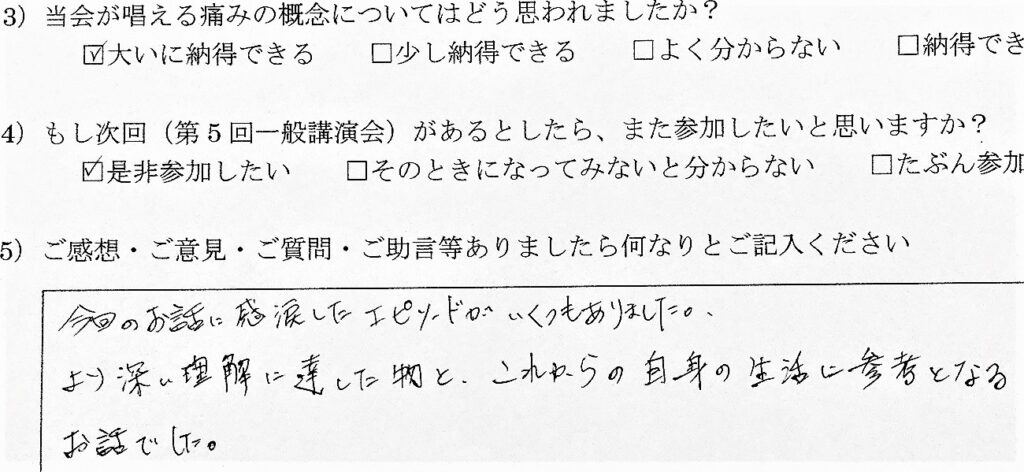
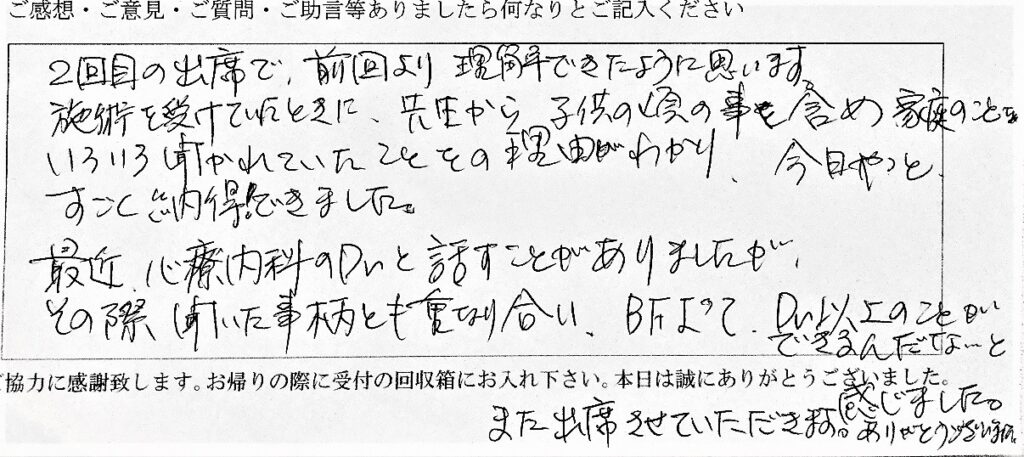

認知科学統合アプローチ(COSIA)に興味のある方へ
画像ラベリングと痛みの原因診断が乖離する現状において、世界疼痛学会(IASP)は痛みの定義を改訂し、「痛みの感情起源説」にシフトしています。
COSIAに興味のある方は是非一度「医療者・セラピスト専用サイト」にお越しください。貴殿のご参画をお待ちしております。
